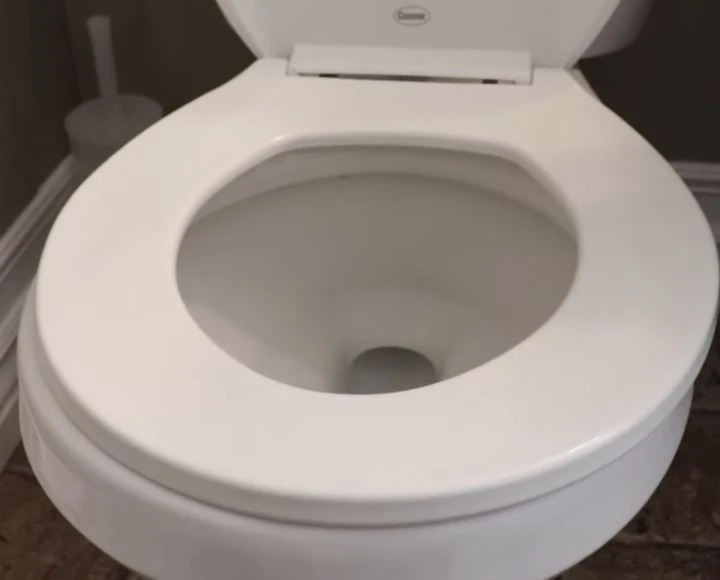There’s nothing more unpleasant than seeing stains on your toilet seat, but where do they come from and what causes them?
Usually, black stuff on a toilet seat is actually black mold, which commonly appears on surfaces in the bathroom because of the high humidity. It can be easily wiped away with a bleach-based cleaner but you might need a more gentle solution, like baking soda and vinegar.
Read ahead to discover more about this issue and what you can do to keep your toilet seat looking white and spotless.
What Is The Black Stuff On My Toilet Seat?
There are a number of different things that can cause black discoloration on your bathroom surfaces, and it is possible that you are actually seeing marks from something like mascara or eyeliner.
Usually, though, marks from these products are more likely to appear on your sink and mirror than on your toilet seat.
Most black patches in the bathroom are actually black mold. It is an incredibly common problem in this particular room of the house because it grows in areas that are consistently damp.
Black mold is a species known more technically as Stachybotrys Chartarum. It grows on organic materials, so it is usually found on paint, wallpaper, plaster, and grout, but it can also grow on the sealing materials on your toilet seat, particularly on the underside.
This mold is not very harmful to most people in small quantities. It can, however, exacerbate respiratory issues in vulnerable people and cause a damp smell.
Why Are Stains Appearing On My Toilet Seat?
The stains that turn up on your toilet seat can have a number of different causes, but the most common can usually be identified by the color.
- Black stains. Black stains are usually caused by black mold.
- Yellow stains. Yellow stains usually come from urine or cleaning products containing bleach.
- Dark orange stains. You might notice dark orange stains around metal components, which are usually caused by rust.
- Beige stains. Some stains inside your toilet can be caused by mineral build-up, like calcium.
To stop black mold from returning, you want to try and keep your bathroom as well-ventilated as possible. Bleach-based cleaning products can also prevent mold from growing back in the same place.
Which Products to Use On Black Toilet Stains
While you can try to get rid of the discoloration on your toilet seat using a generic cleaner, it’s best to choose the right tool for the job.
Black mold can be killed with common household bleach or bleach-based cleaners, or you could opt for a specifically formulated “mold cleaner”. It is important to be careful with these products, though, as they are harsh and may cause damage to a plastic toilet seat. They can even leave a different discoloration if they are left on for too long.
Fortunately, you probably already have an effective and gentle solution in your cupboard. Baking soda and vinegar can both be used to remove the most common stains and build-up that you might find on your toilet seat.
How To Remove Black Toilet Seat Stains Using Vinegar and Baking Soda
So, let’s walk through the steps that you need to take to get that black stuff off your toilet seat.
When you are cleaning, you need to make sure that you are staying safe.
Baking soda and vinegar can be harsh on the skin and eyes, and they can create harmful gasses. The room needs to be properly ventilated, and you should wear both gloves and goggles at all times.
Step 1: Rinse the Toilet Seat
The first step is to thoroughly rinse the entire toilet seat with water. This will show you where the problems are and get rid of any surface-level debris. You can also give a quick spray with an antibacterial cleaning product at this point as well. Wipe down the surfaces when you are done.
Step 2: Mix Baking Soda and Water
Mix a quarter cup of baking soda and around ⅕ cup of warm water to form a paste.
Step 3: Scrub the Stained Surface
Using a gentle scouring pad, apply the paste and scrub in circular motions to remove any build-up. This will get rid of calcium and other deposits that might cause the stains to return. Then, let the paste sit for around 15-20 minutes.
Step 4: Rinse the Surface Again
Give the surface another good rinse and wipe down to remove the paste.
Step 5: Apply White Vinegar
Vinegar acts as a disinfectant and it is mildly acidic, which means it can break down grime and dirt. The easiest way to apply it to your toilet seat is by making a mixture of equal parts white vinegar and water inside a spray bottle. Spray it onto the surface, then leave it to sit for 15-20 minutes.
Step 6: Scrub and rinse
Finally, you can scrub the seat using a scrubbing brush and give it one last rinse.
How To Remove Yellow Toilet Seat Stains
Removing yellow urine stains from your toilet is usually even easier than getting rid of black mold, as there is no organic growth to contend with. The same cleaning method that we explained above should get the job done and leave your toilet looking shiny and clear.
Conclusion
So, what is that black stuff you see on the toilet seat and how do you get rid of it? Usually, this discoloration will be black mold, and you can clean it off relatively easily using mold-killing cleaning products. Keep in mind that harsh cleaning products can damage a plastic toilet seat, so one of the best methods is actually to use baking soda, white vinegar, and a bit of elbow grease.
